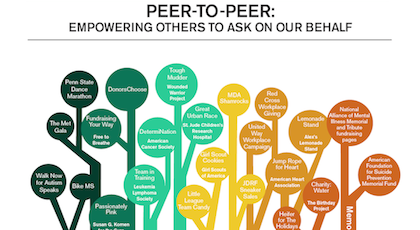By now most of us have received emails and seen Facebook posts from friends and family members asking us to donate to a personal cause or charity that they are involved in. It seems as though charities and organizations have learned that there is great value in asking people to fundraise on their behalf. The online fundraising platform Kimbia has noted this, stating:
“Receiving a donation solicitation from somebody you know, such a close friend or a family member, is 300 times more effective than receiving the same solicitation from your organization.”
Online peer-to-peer fundraising has seen stable growth over the past few years and is quickly becoming a go-to option for individuals and non-profits alike. According to the Network for Good 2014 Digital Giving Index, which provides insights on $233 million in donations to 45,000 nonprofits, online giving grew 9% in 2014 compared to a 3% increase in giving overall.
Remember that many different kinds of fundraisers fit into the peer-to-peer model. The infographic by Plenty Consulting featured in this post can help us break down the different types to give a better understanding of how large peer-to-peer fundraising is really becoming:
Infographic Source by Plenty Consulting.
I’ve put together a new GUIDE that’s packed with science-backed nonprofit fundraising methods, resources, strategies, and killer marketing methods.
You should check it out if you want to get more donations and you want to fast-track the entire process.
Branded Events
A branded event is a fundraiser that is attached to a specific cause or charity, such as Bike MS or the Penn State Dance Marathon. When supported by a strong message and cohesive visuals, these events can help engage potential donors with the cause on an emotional level, and leave a lasting impression even after the event itself is over. Branded events are often used not only to raise money but also to help spread awareness of the cause they represent.
Independent Fundraising Events
Independent fundraising events allow supporters to create their own fundraiser. Examples of these include Passionately Pink (for breast cancer) and Donors Choose (funding education). These organizations make it easy for anyone dedicated to the cause to host an event in their local community under the charity’s umbrella. This type of peer-to-peer fundraising event is great because it empowers individuals to take control and make a visible impact on the other people’s lives.
Third Party
Third party peer-to-peer fundraisers use an existing event to recruit fundraisers. A few of these include the Great Urban Race, which helps raise money for St. Jude Children’s Research Hospital, and The American Cancer Society DetermiNation program. Both of these are races that allow you to focus on your personal health and have fun while helping others. Many companies are leveraging the third party fundraising model by using the internet to give fundraisers everywhere the tools they need to attract more donors to the cause, some with great success.
Consumer Focused
Consumer focused peer-to-peer fundraisers provide a product for people to sell, such as Girl Scout Cookies and JDRF Sneaker Sales. The first is an example of personal sales that benefit the fundraiser’s local Girl Scout council, while the second asks groups (including businesses, schools, and individuals) to sell paper sneakers to help raise money for the Kids Walk to Cure Diabetes.
Community Based
Community based fundraisers work by leveraging existing communities to reach into their networks. These can include fundraisers like Jump Rope for Heart, which is run by schools, or a United Way Workplace Campaign. These workplace fundraisers are taken on by businesses to help local branches of the United Way. Community based fundraising initiatives are focused on benefitting the lives of people in specific cities or communities.
Personal Milestones
Peer-to-peer fundraisers that focus on personal milestones encourage you to use your own life events as fundraising platforms. One personal milestone fundraiser is Charity: Water, the birthday project. This initiative lets individuals start a fundraising page close to their birthday and ask people to donate to clean water for their big day. Others, such as the American Foundation for Suicide Prevention Memorial Fund, allow people to establish a memorial fund to honor someone (in this case, a loved one they lost to suicide) and raise money in an effort to work towards better prevention methods.
I’ve put together a new GUIDE that’s packed with science-backed nonprofit fundraising methods, resources, strategies, and killer marketing methods.
You should check it out if you want to get more donations and you want to fast-track the entire process.
Conclusion
As you can see, there are many different kinds of peer-to-peer fundraising, most of which have been adapted to include online giving in the past few years. If you’d like to learn in-depth about peer to peer fundraising, check out the podcast we did with MMORE here or on iTunes or the podcast we did with the nonprofit crowdfunding consultant, Rose Spinelli. The examples in this post provide only a quick snapshot of hundreds of thousands of programs that are currently using the peer-to-peer fundraising model.
That number will likely keep growing as peer-to-peer fundraising asserts itself as a more personal and involved way to raise money for the charities and causes that are important to us. So far, this growth in peer-to-peer fundraising has coincided with the creation of many new online fundraising platforms, including Classy, CrowdRise, DepositAGift, and First Giving (you can find more information on these sites here).





